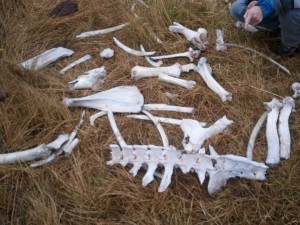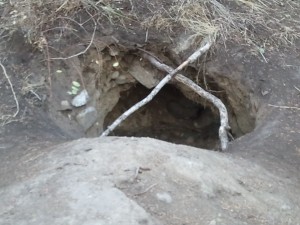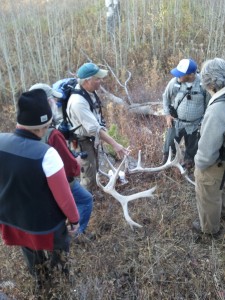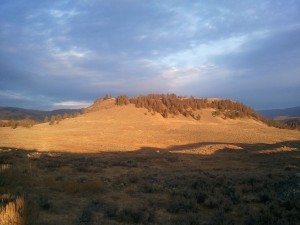At the Hell Roaring Creek overlook, just before first light, 10 of us are standing in the darkness listening for the howls of wolves. We are emptying ourselves so as to only listen and look. We are trying to quiet our minds. The sky begins to show red and pink indentations in clouds. Brad is watching for ravens, “little scouts, hoping for something to die”.*
Some of us see ourselves as kin to certain animals – dogs, cats, wolves, bears (who when skinned out are said to look like a man), some of the great apes, raptors, songbirds, and if not kin, then protectors, sympathetic onlookers who seek to preserve their habitat or species or even individual lives. For example, wolves bring in $35 million to $70 million a year to the Yellowstone area from visitors who travel here primarily to see them. We met individuals who bought homes just outside the Park so they could be here every day to watch them, to listen to their howls, to connect their daily lives to them.
Dogs, my own Wolfie included, are Canis Lupus Famaliaris and are descendants of wolves, but gray wolves, Canis Lupus, are pure carnivores – they possess carnassi, teeth evolved the better to grab, crush and tear their prey. The debate as to how they crossed over and were domesticated has not been resolved. One of their antecedents, the Dire Wolf, an Ice Age brand, stood five feet tall at the shoulders and would have been able to look most humans of the time in the eye “before it ate them”.*
The last wolf in Yellowstone was shot in 1926. Reintroduced in 1995, there are now over 300 in Yellowstone alone, formed into about 9 evolving, shifting packs. The names of the packs have their own poetry – the Lamar Canyon, the Rose Creek and the Agate Creek, the Blacktail, the Druid’s and the Mollies, the Leopold, the Chief Joseph and the Canada. Gray is the normal color of most wolves, the purest of the species, whites are rare and blacks, indicative of an infusion of long ago dog DNA, surprisingly common.
Brad Bulin, a wildlife biologist and our instructor for the Yellowstone Association Field Seminar on Wolves, loves the animal; he just isn’t in love with them. He loves the species and has respect for the individual, but there is nothing sentimental about his regard. He makes every attempt to see them clearly, to communicate that clarity to his classes through facts and stories, and thus to teach his students how to see them. He loves this place and this work. His stories not only illustrate ecological facts but are filled with drama and mystery. He is the best kind of teacher, one thoroughly integrated into both
the present moment and this glorious, wild country.
To begin to see a wolf, stop looking for wolves and watch other Yellowstone species — coyote, magpie, raven and bear, elk and buffalo “do nothing special”.* Watch them grazing, walking along, at ease with their surroundings. Those observations will prepare you for changes in their behavior when wolves are present. We may not be able to see the wolves at first, but those species will show their awareness of their presence. Buffalo and elk all turn in their direction, the buffalo lifting their tails straight out. Ravens may follow individuals and packs. Huge numbers of them appear at carcasses. The rule of thumb seems to be, “see a raven, watch for a wolf”*. Look for blood under the chin of a coyote which may indicate it has fed from a recent wolf kill. They will howl when wolves are present: “something is wrong in coyote land”.* Even bears will be nervous, particularly sows with cubs. When you see one, a wolf will “swagger”, while a coyote’s legs will shift “in a rhythm like eggbeaters” and foxes will look like the “little Princess Victoria’s”* of the canine world, dressed in red finery and a marvelous tail longer than their bodies. In the darkness at Hell Roaring I hope for the gold standard of an observational experience: I see you, you don’t see me.

Walking in Yellowstone with Brad is equivalent to taking the best kind of natural history course. In the open air, we learn how to read the weather and why the Lamar Valley will experience sinking temperatures in full sun. We learn how weasels will attack a hornet’s nest and the importance of a moisture line on the edge of a tree-line; grizzlies will walk that moisture line scavenging for food. We learn about the behavior of badgers and the astonishing, super-animal habits of wolverines who may covet 10,000 square miles of territory for their range. We learn how to put Elk and Buffalo bones together, why predators will crack those bones open for marrow, why wolves will eat the belly, organs and blood of their prey first, and how to read tracks, scat, and soil chemistry. We learn about the nature of dens. We learn how to avoid being attacked by buffalo, why aspen are increasingly scarce in the Park, and why wolves preying on Elk help the botanical health of the Park as a whole. We learn that wolves can probably smell a bad tooth in an elk, evidence of an infection, and therefore weakness. We learn that wolves average about 4 years of life here (Howlers Inn wolves live from 12 to 14 years) and that only 20% make it past 2 years of age.
We learned about wolf #8, whose skeleton upon examination after his natural death revealed “…his muzzle to be riddled with holes from a bone infection, his canine teeth loose and blunted. … Yet a week before he died, wolf watchers had shot a video of [him] hanging on to an elk during a hunt – loose, dull teeth and all.”** We learned about wolf #21, a barrel-chested alpha who fought grizzlies to protect pups and who left kills to allow pups to feed first; #21, who approached the Druid pack alone and who, when surrounded, neither submitted nor fought but played, and whose obvious strength and charisma brought him alpha status in their pack; #21, who “lived to be 9 years old despite an injury to the top of his skull and cracked and worn teeth.”**
I had to make an effort not to see wolves as our avatars, as primarily symbolic creatures, but my God, 8 and 21 began to seem like Hector and Achilles, paragons of excellence, exemplars of nobility.
Brad led us to wolves on all three days of our course. On day 1, high up and far away, three very close together, touching, tails wagging, traveling in that eat-up-the-miles lope. On day 2, at nightfall, two at the crest of a hill 200 yards above us, one white and one black, lying down and watching us. Day 3 gave us the best, longest sighting. It was also our “three dog day”.*
From 30 feet away we watched a coyote recovering from mange hunting for mice among the high grass along a pond. He weighed about 20 pounds and crept slowly along, listening. We saw him launch himself up, pounce, come up to sight with his jaws snapping-snapping and then gnashing and swallowing a mouse or a vole. A few minutes later in a marsh came a fox, also hunting, his red fur bursting like ripe fruit and a white tipped tail looking as if it had been dipped in paint. He cocked his head from side to side. Once he glanced at us, only curious. He must sense that we won’t eat him.
And then, a few minutes after the coyote and fox, from two hundred yards away, we saw 4 wolves coming across the crest of a hill, 2 blacks and 2 grays. Our binoculars brought them close enough to read their facial expressions. The first gray looked at us steadily for long seconds. We looked into his eyes. This was personal. I stopped breathing so I could fix the binoculars in my hands and keep his eyes in mine.
Three of them seemed to move purposefully across our field of sight, two grays heading for the entrance to the Petrified Tree Trail, and one black patiently climbing the ridge to the north. Their bellies were distended. They may have been heading back to feed pups.
The second black was a yearling. He followed minutes after the first three. We watched him sit on a hillside, his left profile facing us, looking for his mates. He began to howl. Head back, he let go of one nervous, quavering howlllll after another, all of them sounding so mournful, so lost. Wolf and pack are synonymous. Wolves are not isolatos. It was impossible to listen and not be moved by his loneliness. This was personal. We watched him for minutes, dazed by his presence. Eventually, he picked up a scent trail, followed the path of the two grays, disappeared into a draw, and left behind in my mind’s eye an enduring image, one to summon again and again in the ease of Pennsylvania.
Much of the factual information for this Post has been collected from Decade of the Wolf by Douglas Smith and Gary Ferguson and from data provided by Brad Rubin’s Wolf Discovery Packet. The quotes are all pure Brad*.
**“Wolf bones tell tales of the will to survive”: Billings Gazette, October 15, 2011
I strongly recommend two DVDs on Yellowstone, wolves and bears, both available from Nature: Clash: Encounters of Bears and Wolves and In the Valley of the Wolves; Christmas in Yellowstone.


